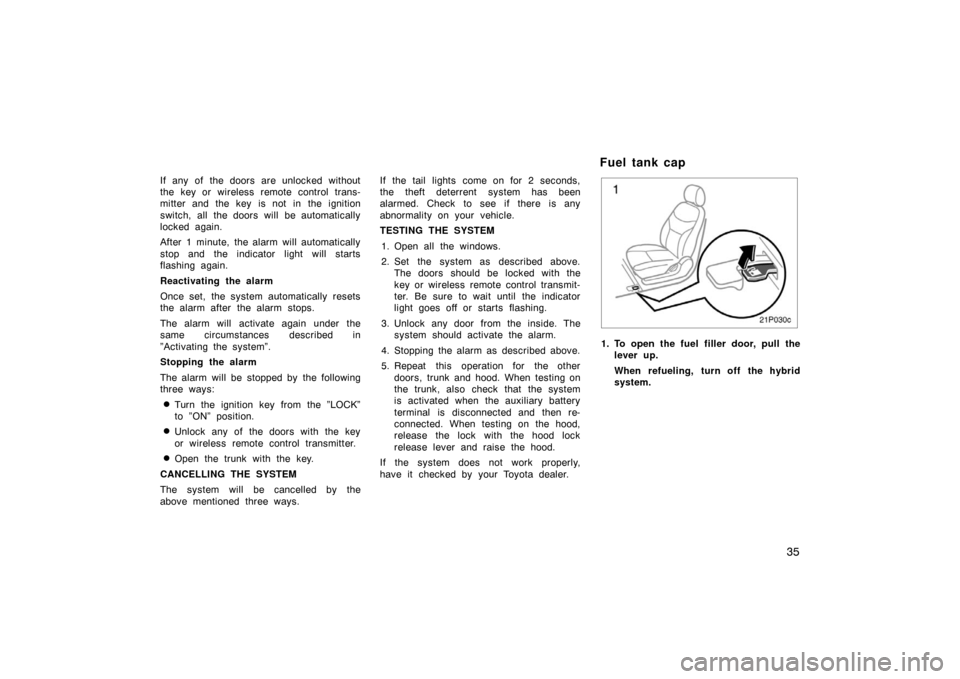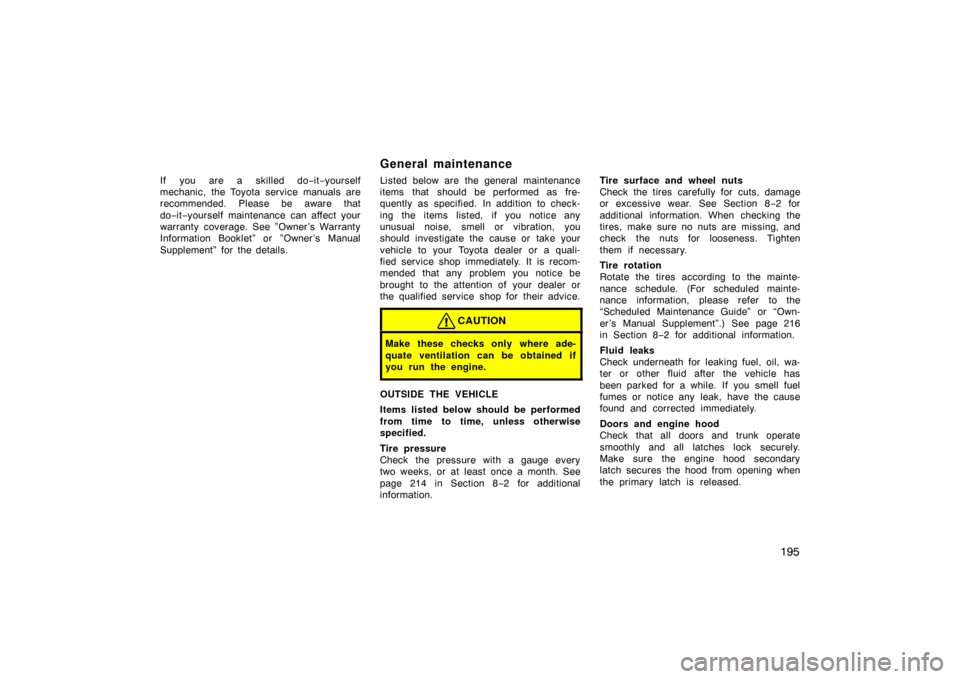Page 15 of 258
2
Instrument panel overview
1. Side vents
2. Side defroster outlets
3. Instrument cluster
4. Center vents
5. Running mode selector lever
6. Power door lock switches
7. Power window switches
8. Glove box
9. Auxiliary boxes
10. Tilt steering lock release lever 11. Hood lock release lever
12. Parking brake pedal
13. Window lock switch
11p003b
Page 45 of 258
32
21p042
After closing the trunk lid, insert the
master key and turn it counterclockwise
to deactivate the lock release lever.
After closing the trunk lid, try pulling it up
to make sure it is securely locked.
—Internal trunk release handle
21p033c
If a person is locked in the trunk, he
or she can pull down the phosphores-
cent handle on the inside of trunk lid
in case of emergency to open the trunk
lid.
The phosphorescent (glow−in −the −dark)
handle will continue to glow for a time
after the trunk lid is closed. Exposing the
handle to stronger light will cause it to
glow longer.
21p026a
To open the hood:
1. Pull the hood lock release lever. The hood will spring up slightly.
CAUTION
Before driving, be sure that the hood
is closed and securely locked. Other-
wise, the hood may open unexpected-
ly while driving and an accident may
occur.
—Lock release lever
cancelling system Hood
Page 48 of 258

35
If any of the doors are unlocked without
the key or wireless remote control trans-
mitter and the key is not in the ignition
switch, all the doors will be automatically
locked again.
After 1 minute, the alarm will automatically
stop and the indicator light will starts
flashing again.
Reactivating the alarm
Once set, the system automatically resets
the alarm after the alarm stops.
The alarm will activate again under the
same circumstances described in
”Activating the system”.
Stopping the alarm
The alarm will be stopped by the following
three ways:
�Turn the ignition key from the ”LOCK”
to ”ON” position.
�Unlock any of the doors with the key
or wireless remote control transmitter.
�Open the trunk with the key.
CANCELLING THE SYSTEM
The system will be cancelled by the
above mentioned three ways. If the tail lights come on for 2 seconds,
the theft deterrent system has been
alarmed. Check to see if there is any
abnormality on your vehicle.
TESTING THE SYSTEM
1. Open all the windows.
2. Set the system as described above. The doors should be locked with the
key or wireless remote control transmit-
ter. Be sure to wait until the indicator
light goes off or starts flashing.
3. Unlock any door from the inside. The system s hould activate the alarm.
4. Stopping the alarm as described above.
5. Repeat this operation for the other doors, trunk and hood. When testing on
the trunk, also check that the system
is activated when the auxiliary battery
terminal is disconnected and then re-
connected. When testing on the hood,
release the lock with the hood lock
release lever and raise the hood.
If the system does not work properly,
have it checked by your Toyota dealer.
21p030c
1. To open the fuel filler door, pull the lever up.
When refueling, turn off the hybrid
system.
Fuel tank cap
Page 208 of 258

195
If you are a skilled do−it−yourself
mechanic, the Toyota service manuals are
recommended. Please be aware that
do− it−yourself maintenance can affect your
warranty coverage. See ”Owner ’s Warranty
Information Booklet” or ”Owner ’s Manual
Supplement” for the details.
General maintenance
Listed below are the general maintenance
items that should be performed as fre-
quently as specified. In addition to check-
ing the items listed, if you notice any
unusual noise, smell or vibration, you
should investigate the cause or take your
vehicle to your Toyota dealer or a quali-
fied service shop immediately. It is recom-
mended that any problem you notice be
brought to the attention of your dealer or
the qualified service shop for their advice.
CAUTION
Make these checks only where ade-
quate ventilation can be obtained if
you run the engine.
OUTSIDE THE VEHICLE
Items listed below should be performed
from time to time, unless otherwise
specified.
Tire pressure
Check the pressure with a gauge every
two weeks, or at least once a month. See
page 214 in Section 8 −2 for additional
information. Tire surface and wheel nuts
Check the tires carefully for cuts, damage
or excessive wear. See Section 8
−2 for
additional information. When checking the
tires, make sure no nuts are missing, and
check the nuts for looseness. Tighten
them if necessary.
Tire rotation
Rotate the tires according to the mainte-
nance schedule. (For scheduled mainte-
nance information, please refer to the
“Scheduled Maintenance Guide” or “Own-
er ’s Manual Supplement”.) See page 216
in Section 8− 2 for additional information.
Fluid leaks
Check underneath for leaking fuel, oil, wa-
ter or other fluid after the vehicle has
been parked for a while. If you smell fuel
fumes or notice any leak, have the cause
found and corrected immediately.
Doors and engine hood
Check that all doors and trunk operate
smoothly and all latches lock securely.
Make sure the engine hood secondary
latch secures the hood from opening when
the primary latch is released.